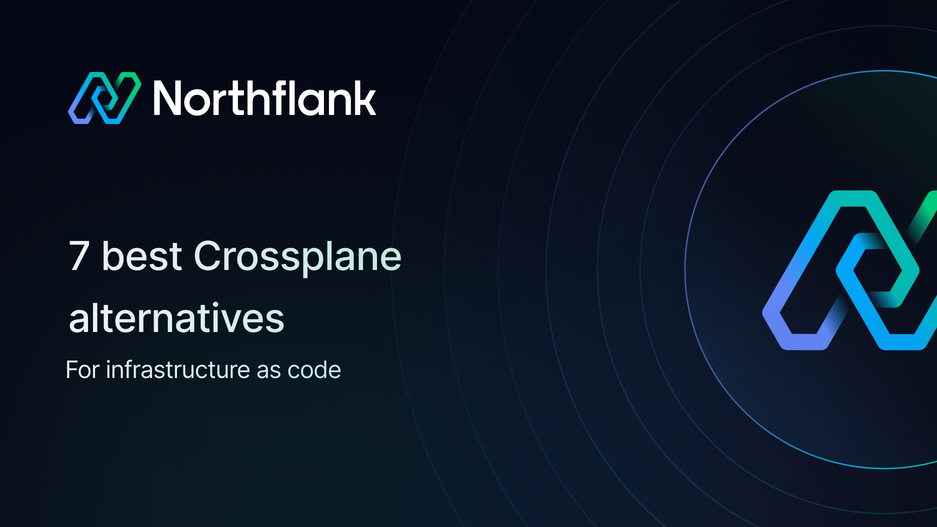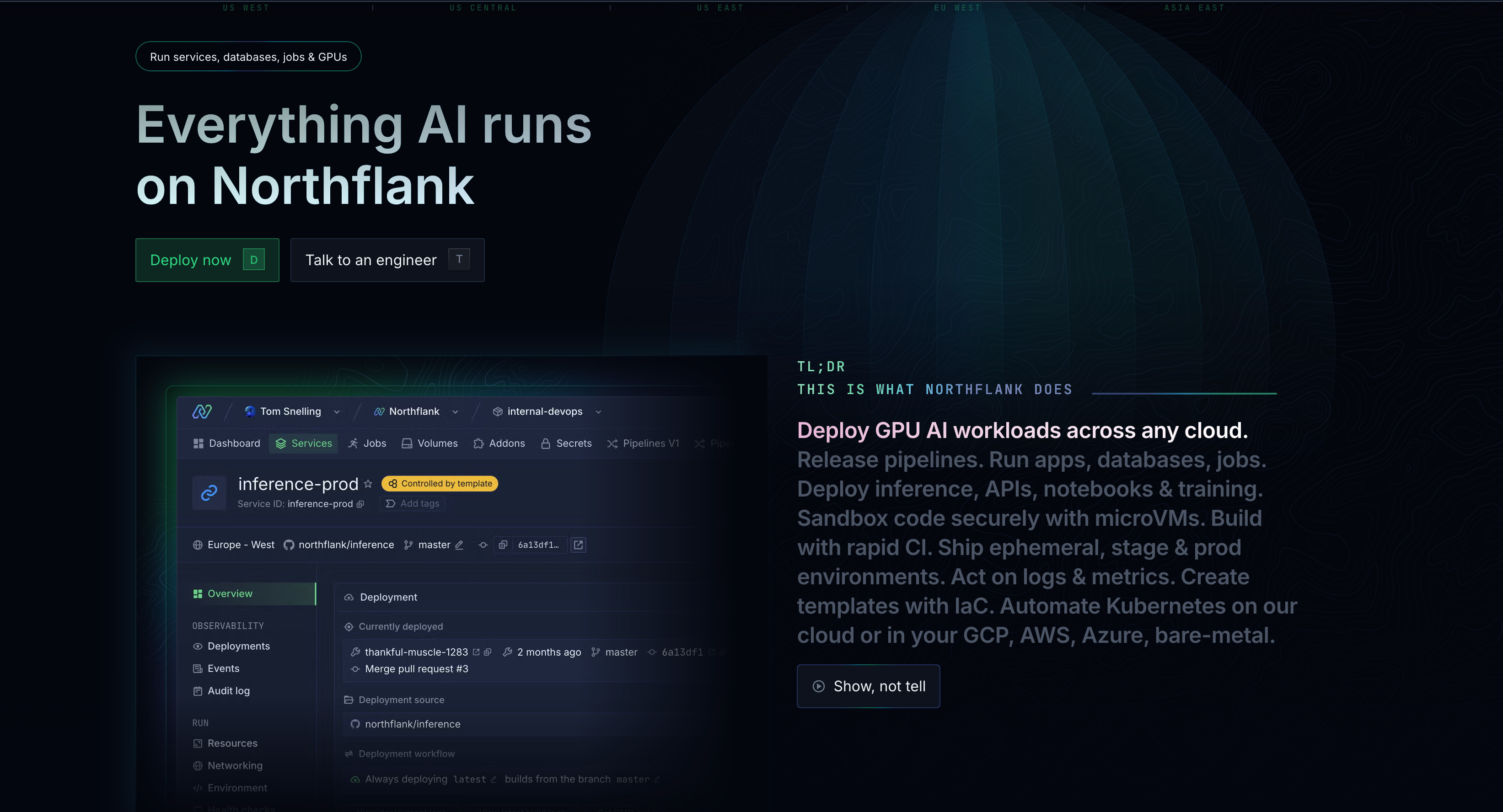

7 best Crossplane alternatives for infrastructure as code
Crossplane offers Kubernetes-native infrastructure management through control planes, but its steep learning curve, operational complexity, and ecosystem changes have teams searching for alternatives. Here are the top options:
- Northflank - Developer platform that abstracts infrastructure complexity with templates, GitOps, and multi-cloud deployment (Northflank's managed cloud or your own AWS/GCP/Azure accounts). Handles full-stack apps to AI workloads with built-in observability, backups, and compliance. Delivers self-service infrastructure without Kubernetes expertise.
- Terraform/OpenTofu - IaC tools with extensive ecosystems and provider support. OpenTofu is the open-source fork maintaining OSS licensing.
- Pulumi - Code-first IaC using TypeScript, Python, Go, or C#. Treat infrastructure like application code with familiar programming languages.
- AWS CDK / CloudFormation - AWS-native IaC with CloudFormation templates or CDK's programming language support for AWS infrastructure.
- Google Config Connector - Kubernetes-native GCP resource management for teams on Google Cloud. Optimized for GKE with deep integration.
- Ansible - Configuration management and provisioning tool with agentless architecture and straightforward YAML playbooks for multi-cloud automation.
Not all infrastructure tools are built the same. Try answering these questions and using the following as a criteria checklist:
- Do you need Kubernetes-native infrastructure management? If your team isn't heavily invested in Kubernetes, look out for tools that don't require running a cluster just for IaC.
- What's your team's level of expertise? Teams without deep Kubernetes knowledge benefit from platforms with simpler abstractions or traditional IaC tools with gentler learning curves.
- How important is true open source? After recent licensing changes, verify whether tools maintain genuine open-source licenses without commercial restrictions on critical components.
- What's the provider ecosystem coverage? Ensure the alternative supports all cloud resources and services your infrastructure requires with mature, well-maintained providers.
- What operational overhead can you accept? Decide if you want to manage infrastructure state, run control planes, or prefer managed solutions that handle operations for you.
- Do you prefer declarative or imperative approaches? Some teams work better with YAML and declarative configs, while others prefer writing infrastructure as code in programming languages.
Let's review seven Crossplane alternatives based on their approach to infrastructure management, operational complexity, and more, to help you find the most suitable solution for your organization or team's needs.
Northflank is a developer platform that solves the same problems as Crossplane (self-service infrastructure and application deployment) but takes a different approach: it abstracts away complexity instead of exposing it.

What sets Northflank apart:
- Infrastructure abstraction - No Kubernetes expertise required. Northflank handles the complexity while you focus on deploying applications and infrastructure.
- Template-based IaC - JSON-based templates with visual editor and bidirectional GitOps. Define infrastructure workflows without complex YAML or CRDs.
- Bring Your Own Cloud (BYOC) - Deploy to your AWS, GCP, Azure, Civo, or Oracle accounts while using Northflank's managed platform layer. Control data residency and cloud costs without operational overhead.
- Unified platform - Handle microservices, APIs, databases, jobs, and GPU workloads from a single interface with built-in observability, backups, and rollbacks.
- Multi-cloud flexibility - Deploy to Northflank's managed cloud or your own infrastructure seamlessly. No vendor lock-in.
- Production-ready features - Built-in health checks, automated backups, disaster recovery, and RBAC.
Best for: Teams wanting self-service infrastructure and GitOps workflows without Kubernetes complexity. Organizations needing enterprise compliance, multi-cloud deployment, or those frustrated with Crossplane's operational overhead.
Pricing:
- Developer Sandbox: Free tier for testing & always-on compute (no sleeping)
- Pay as you go: only pay for consumption, infinitely scalable, 6+ cloud regions, 600 BYOC regions, and deploy with CPU & GPU
- Enterprise: Custom requirements, SLAs, white-label, and always-on support (ability to run in your VPC, 24/7 support & SLA, FDE onboarding, & 100+ Enterprise features)
(See full pricing details)
Try Northflank's free Developer Sandbox or book a demo to speak with an engineer.
Terraform is the standard for infrastructure as code, using HashiCorp Configuration Language (HCL) to define infrastructure declaratively. OpenTofu emerged as the open-source fork after HashiCorp's license change, maintaining OSS licensing.

Key characteristics:
- Declarative HCL syntax with wide adoption and extensive documentation
- Extensive provider ecosystem covering cloud platforms and services
- State management tracks infrastructure across teams
- Plan/apply workflow shows changes before execution
- Community support and module registry
Considerations:
- Requires learning HCL domain-specific language
- State management adds operational complexity
- No built-in continuous reconciliation like Kubernetes-native tools
- Can become verbose for complex infrastructure setups
Best for: Teams needing IaC with extensive provider coverage. Organizations wanting traditional infrastructure provisioning without Kubernetes dependencies.
Pulumi brings infrastructure as code into familiar programming languages (TypeScript, Python, Go, C#, and Java) allowing teams to use software engineering practices for infrastructure.

Key characteristics:
- Write infrastructure in programming languages with IDE support
- Use standard testing frameworks and debugging tools
- Leverage packages, functions, and classes for abstraction
- State management handled by Pulumi service or self-hosted backends
- Import existing Terraform providers through compatibility layer
Considerations:
- Less declarative than pure IaC tools (more imperative code)
- Smaller ecosystem than Terraform though growing rapidly
- Requires development skills rather than pure operations knowledge
- Team must align on programming language choice
Best for: Development teams preferring to treat infrastructure as software. Organizations with strong programming expertise wanting familiar tooling and testing practices.
AWS Cloud Development Kit (CDK) and CloudFormation provide native infrastructure as code for AWS resources, with CDK offering programming language abstractions over CloudFormation's JSON/YAML templates.

Key characteristics:
- Native AWS integration with comprehensive service coverage
- CDK supports TypeScript, Python, Java, C#, and Go
- CloudFormation handles state management automatically
- Built-in rollback and change set previews
- No additional tooling required for AWS infrastructure
Considerations:
- AWS-only (no multi-cloud support)
- CloudFormation templates can be verbose and complex
- Limited to AWS's update cadence for new services
- CDK abstractions add another layer to understand
Best for: AWS-centric organizations not requiring multi-cloud. Teams wanting official AWS tooling with guaranteed service coverage.
Config Connector is Google's Kubernetes-native solution for managing GCP resources, similar to Crossplane but specific to Google Cloud Platform.

Key characteristics:
- Kubernetes-native GCP resource management through CRDs
- Integrated with GKE and Google Cloud's IAM
- Declarative YAML-based resource definitions
- Continuous reconciliation like Crossplane
- Official support from Google Cloud
Considerations:
- GCP-only (not multi-cloud like Crossplane)
- Requires Kubernetes cluster and Kubernetes expertise
- Smaller resource coverage compared to Terraform
- Limited community compared to broader IaC tools
Best for: Teams heavily invested in both Kubernetes and Google Cloud. Organizations wanting Kubernetes-native infrastructure management without multi-cloud complexity.
Ansible is an agentless automation tool that handles configuration management and infrastructure provisioning through straightforward YAML playbooks, without requiring agent software on managed nodes.

Key characteristics:
- Agentless architecture using SSH connections
- Straightforward YAML playbooks readable by operations and development teams
- Idempotent operations ensure consistent results
- Extensive module library for cloud provisioning and configuration
- Can complement other IaC tools for post-provisioning configuration
Considerations:
- More imperative than purely declarative IaC tools
- No built-in state management like Terraform
- Best for configuration management; often paired with other tools for provisioning
- Can become complex for large-scale infrastructure orchestration
Best for: Teams needing configuration management alongside infrastructure provisioning. Organizations wanting agentless automation with minimal setup overhead.
Selecting a Crossplane alternative depends on your team's expertise, infrastructure requirements, and operational preferences:
| Platform | Choose if you... |
|---|---|
| Northflank | Want self-service infrastructure and GitOps without Kubernetes complexity. Your team needs enterprise features, multi-cloud flexibility, or you're building production applications requiring compliance and observability. |
| Terraform/OpenTofu | Need IaC with extensive provider coverage. Your team prefers traditional IaC tooling without Kubernetes dependencies and wants extensive community support. |
| Pulumi | Want to write infrastructure in familiar programming languages. You value IDE support, testing frameworks, and treating infrastructure like application code. |
| AWS CDK/CloudFormation | Are building exclusively on AWS and want native tooling. Your team prefers AWS-guaranteed service coverage and built-in state management. |
| Config Connector | Are heavily invested in both GKE and Google Cloud. You want Kubernetes-native resource management without multi-cloud complexity. |
| Ansible | Need agentless configuration management and provisioning. Your team wants straightforward YAML playbooks without complex state management. |
Crossplane pioneered Kubernetes-native infrastructure management, but ecosystem changes and inherent complexity have led teams to reconsider their approach.
If you're frustrated with provider restrictions, operational overhead, or steep learning curves, alternatives exist across the spectrum, from traditional IaC tools to modern developer platforms.
For teams wanting Crossplane's self-service approach without its complexity, Northflank delivers infrastructure abstraction with enterprise-grade features. You get GitOps workflows, multi-cloud deployment, and production observability without requiring Kubernetes expertise.
To simplify your infrastructure management, try Northflank's free Developer Sandbox or schedule a demo to see how it compares to Crossplane for your specific needs.